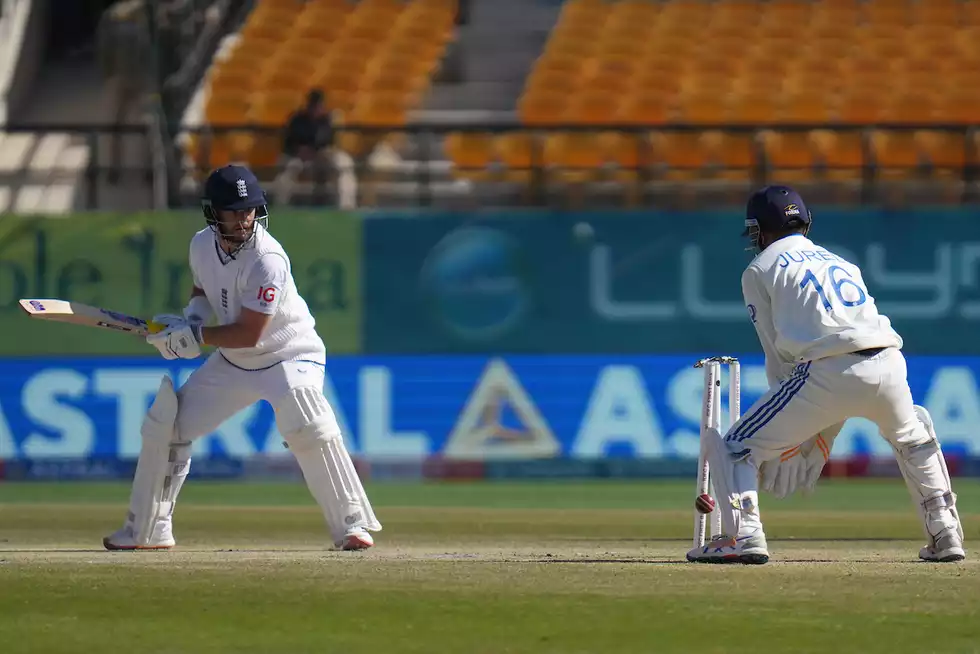India is a reflection of England’s trends in Test cricket.
India is a reflection of England’s trends in Test cricket.
Ben Stokes had little to say about it. After switching ends, Ravichandran Ashwin bowled just one over prior to lunch. It leaves England five down with a slider that slipped between Stokes’s bat and pad. Instead of an expressive shrug at being written off, there was more of a sigh of pure helplessness—possibly a resignation to the realization that anything less than a 3-2 result was unattainable.
You might attribute Stokes’s departure to a number of things, including the England captain’s personal form this series. His susceptibility to play spin, as well as the deft usage of variations by a 500-wicket, 100-Test spin veteran. However, England shouldn’t have started the day with him in the middle of things. The flaws in Bazball that have emerged during their fifteen-day journey in India were revealed by three of the four wickets that fell before Stokes.
India is without a doubt one of the hardest venues to play away Tests at the moment. However, England’s rapid change of circumstances on the third morning was more self-inflicted. On a field that still didn’t do much for the bowlers, England’s hitters had the best chance to learn from India’s Day 2 batting display, albeit with a sizable disadvantage. In the face of constant pressure, however, they continue to adhere to their policies of what has frequently resembled mindless brutality.
Ashwin’s go-to weapon against an agitated Ben Duckett was variations in speed and dip. The England opener failed to sweep on the very first ball he faced. Two balls later, he ran down the track. Only to be bowled after being tricked in the air by a considerably slower delivery. Jasprit Bumrah gave Zak Crawley two maiden overs, and the close-in fielders around him sensed the dot-ball pressure building.
With another that spun hard and went through for a bye, Ravichandran Ashwin shook him even more. Then, using a tactic he’s employed with success against players like Steve Smith, he moved Sarfaraz Khan from forward short leg to a position marginally closer to leg slip This caused the ball to veer toward the leg stump. When Crawley saw the line, he attempted to flick the turn and hit Sarfaraz directly.
Ollie Pope has been task with trying to unshackle India’s spinners this series. Even though he hasn’t succumbed to pacers. He may have made a game-changing century in Hyderabad, but he has more often failed at this attempt than succeeded. But Pope and England stuck to this plan, even though the game was still on Saturday. There’s no other explanation for Pope’s deliberate attempt to remove Ravichandran Ashwin when the spinner was receiving additional bounce from a length and keeping the lone close-in fielder engaged. Similar to the opening over, Pope top-edged to Yashasvi Jaiswal at square leg, and the outcome wasn’t pleasant.
Joe Root proved in the post-lunch session that many of England’s morning-session problems. It might have been avoid with even a small amount of resiliency. As he hit some beautiful strokes against both pace and spin without exerting much effort on route to another half-century.
This raises some concerns regarding England’s Test habits: can the dictum “this is how we play” work everywhere? Stokes rejected the idea that their high-risk philosophy must be trade off for the humiliating lows in India following the historic highs of a series victory in Pakistan. However, their unwavering dedication to this purpose has let them down at key times that define the series.
Ben Duckett’s century gave England a chance to take the lead at the beginning of the third day in Rajkot. After India scored 445 in the opening innings, England rallied to reach 207/2 by day’s end. But after Joe Root’s uncalled-for reverse rampage against Bumrah, England just crumbled, not reducing the deficit. After he fell, the others did too, and England’s score went from 224 for 2 to 319 all out. It clears the air and giving India a commanding advantage to work with in the first innings.
They blew a slim advantage in the first inning in Ranchi due to even worse batting decisions made. In fewer than two sessions. The team that batted for 104 overs over the course of the first two days in the first innings was defeat in just 53.5 overs.
With an inexperienced bowling attack, England’s hitters had to come forward. They perform much of the heavy lifting in this series. Pope batted for more than 50 balls in just two innings over the four losses, whereas Duckett had only done so once, and that was during his century in the Rajkot match. Kuldeep Yadav batted for 91 balls at Rajkot, 131 in Ranchi, and 69 in Dharamsala, to put these figures into perspective. As India’s spinners Ravichandran Ashwin and Bumrah alternated. Stokes concluded the series on 199 runs, with seven scores of less than 20, undermining the impression that he was England’s great rescuer.
Overall data nevertheless indicates that England’s efforts to lead the charge in revitalizing Test cricket have merit. After all, this is their first series loss since they assumed control in 2022 under the Stokes-McCullum combination. Once the dust settles and a post-mortem is attempted. All roads will ultimately lead to some kind of tempering.. For England’s hostility to be widely effective, it must be accompanied with an asterisk.


